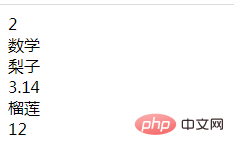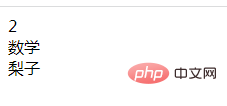 Backend Development
Backend Development
 PHP Problem
PHP Problem
 How to traverse an array in php and only take the first three elements
How to traverse an array in php and only take the first three elements
How to traverse an array in php and only take the first three elements
php method to traverse an array and only take the first three elements: 1. Use the for statement to loop through the array, the syntax is "for($i=0; $i
2 ){break;}else{echo $array[$i]."
";}".($array);>

The operating environment of this tutorial: windows7 system, PHP8 version, DELL G3 computer
In php , you can use the for statement and if statement to traverse the array and only take the first three elements.
The for statement is used to traverse the array
The if statement is used to limit the number of traversals and obtain the first three elements
Detailed steps:
Step 1. Use the for statement to loop through the array
For syntax for looping through the array The format is as follows:
for ($i=0; $i< 数组长度; $i++) {
//循环体语句块;
}Let’s take a look at the code example below:
<?php
header("Content-type:text/html;charset=utf-8");
$array= array(2,"数学","梨子",3.14,"榴莲",12);
for ($i=0; $i < count($array); $i++) {
echo $array[$i] . "<br/>";
}
?>
At this time, all elements will be obtained, and restrictions need to be added to the loop body. .
Step 2: In the loop body, use the if statement to determine whether the variable $i is greater than 2. If it is greater than 2, use the break statement to jump out of the loop. If it is not greater, continue to output elements
If it is greater, it means that the array has been traversed 3 times and the first three elements have been obtained. At this time, you need to use the break statement to jump out of the loop
If it is not greater, the first three elements have not been obtained and the output continues.
<?php
header("Content-type:text/html;charset=utf-8");
$array= array(2,"数学","梨子",3.14,"榴莲",12);
for ($i=0; $i < count($array); $i++) {
if($i>2){
break;
}else{
echo $array[$i] . "<br/>";
}
}
?>
ok, you can see that the first three elements are output.
Extended knowledge: for loop statement
The for loop will pre-define the variable that controls the number of loops in the for statement, so the for loop statement Able to perform loop operations according to a known number of loops, suitable for situations where the number of times the script needs to be run is clearly known.
The syntax format of the for loop is as follows:
for (初始化语句; 循环条件; 变量更新--自增或自减) {
语句块;
}The for loop statement can be disassembled into 4 parts: three of the () Expressions and "statement blocks" in {}, let's analyze them below.
Statement analysis:
#Initialization statement (expression 1): mainly initializes a variable value, used to set a counter , which is the value at the beginning of the loop; this statement is only executed during the first loop and will not be executed again in the future.
Loop condition (expression 2): Restriction condition for loop execution, used to control whether to execute the code in the loop body; if the condition is TRUE, the loop continues, if the condition is FALSE , the loop ends and exits the loop immediately.
Variable update (expression 3): an expression with an increment or decrement operation. Every time the loop is executed, the value of the counter is immediately modified so that the loop The conditions gradually become "untenable".
Statement block: Several codes that need to be executed when the condition is judged to be true.
Is the above description a bit convoluted? Let’s take a look at the execution flow chart of the for loop statement to understand the execution of the for loop more intuitively. Process:

# Now that we understand the execution process of the for loop, let’s do the actual operation and do a small question to see if we have mastered it!
Training question:
Calculate the sum of adding from 1 to 100
<?php
$sum=0;
for($i=1; $i<=100; $i++){
$sum+=$i;
}
echo '1 + 2 + 3 +...+ 99 + 100 = '. $sum;
?>Output:
1 + 2 + 3 +...+ 99 + 100 = 5050
Let’s change it, since You can find the sum of 1 added to 100, or you can find the product of 1 multiplied by 100 (the factorial of 100)
<?php
$sum=1;
for($i=1; $i<=100; $i++){
$sum*=$i;
}
echo '1 * 2 * 3 *...* 99 * 100 = '. $sum;
?>Output:
1 * 2 * 3 *...* 99 * 100 = 9.3326215443944E+157
Note: Because nothing is multiplied by 0 It is 0, so the initial value of the $sum variable here cannot be 0, but 1.
Recommended learning: "PHP Video Tutorial"
The above is the detailed content of How to traverse an array in php and only take the first three elements. For more information, please follow other related articles on the PHP Chinese website!

Hot AI Tools

Undresser.AI Undress
AI-powered app for creating realistic nude photos

AI Clothes Remover
Online AI tool for removing clothes from photos.

Undress AI Tool
Undress images for free

Clothoff.io
AI clothes remover

Video Face Swap
Swap faces in any video effortlessly with our completely free AI face swap tool!

Hot Article

Hot Tools

Notepad++7.3.1
Easy-to-use and free code editor

SublimeText3 Chinese version
Chinese version, very easy to use

Zend Studio 13.0.1
Powerful PHP integrated development environment

Dreamweaver CS6
Visual web development tools

SublimeText3 Mac version
God-level code editing software (SublimeText3)

Hot Topics
 1667
1667
 14
14
 1426
1426
 52
52
 1328
1328
 25
25
 1273
1273
 29
29
 1255
1255
 24
24
 PHP: A Key Language for Web Development
Apr 13, 2025 am 12:08 AM
PHP: A Key Language for Web Development
Apr 13, 2025 am 12:08 AM
PHP is a scripting language widely used on the server side, especially suitable for web development. 1.PHP can embed HTML, process HTTP requests and responses, and supports a variety of databases. 2.PHP is used to generate dynamic web content, process form data, access databases, etc., with strong community support and open source resources. 3. PHP is an interpreted language, and the execution process includes lexical analysis, grammatical analysis, compilation and execution. 4.PHP can be combined with MySQL for advanced applications such as user registration systems. 5. When debugging PHP, you can use functions such as error_reporting() and var_dump(). 6. Optimize PHP code to use caching mechanisms, optimize database queries and use built-in functions. 7
 PHP and Python: Comparing Two Popular Programming Languages
Apr 14, 2025 am 12:13 AM
PHP and Python: Comparing Two Popular Programming Languages
Apr 14, 2025 am 12:13 AM
PHP and Python each have their own advantages, and choose according to project requirements. 1.PHP is suitable for web development, especially for rapid development and maintenance of websites. 2. Python is suitable for data science, machine learning and artificial intelligence, with concise syntax and suitable for beginners.
 PHP vs. Python: Understanding the Differences
Apr 11, 2025 am 12:15 AM
PHP vs. Python: Understanding the Differences
Apr 11, 2025 am 12:15 AM
PHP and Python each have their own advantages, and the choice should be based on project requirements. 1.PHP is suitable for web development, with simple syntax and high execution efficiency. 2. Python is suitable for data science and machine learning, with concise syntax and rich libraries.
 PHP in Action: Real-World Examples and Applications
Apr 14, 2025 am 12:19 AM
PHP in Action: Real-World Examples and Applications
Apr 14, 2025 am 12:19 AM
PHP is widely used in e-commerce, content management systems and API development. 1) E-commerce: used for shopping cart function and payment processing. 2) Content management system: used for dynamic content generation and user management. 3) API development: used for RESTful API development and API security. Through performance optimization and best practices, the efficiency and maintainability of PHP applications are improved.
 The Enduring Relevance of PHP: Is It Still Alive?
Apr 14, 2025 am 12:12 AM
The Enduring Relevance of PHP: Is It Still Alive?
Apr 14, 2025 am 12:12 AM
PHP is still dynamic and still occupies an important position in the field of modern programming. 1) PHP's simplicity and powerful community support make it widely used in web development; 2) Its flexibility and stability make it outstanding in handling web forms, database operations and file processing; 3) PHP is constantly evolving and optimizing, suitable for beginners and experienced developers.
 PHP vs. Other Languages: A Comparison
Apr 13, 2025 am 12:19 AM
PHP vs. Other Languages: A Comparison
Apr 13, 2025 am 12:19 AM
PHP is suitable for web development, especially in rapid development and processing dynamic content, but is not good at data science and enterprise-level applications. Compared with Python, PHP has more advantages in web development, but is not as good as Python in the field of data science; compared with Java, PHP performs worse in enterprise-level applications, but is more flexible in web development; compared with JavaScript, PHP is more concise in back-end development, but is not as good as JavaScript in front-end development.
 PHP and Python: Different Paradigms Explained
Apr 18, 2025 am 12:26 AM
PHP and Python: Different Paradigms Explained
Apr 18, 2025 am 12:26 AM
PHP is mainly procedural programming, but also supports object-oriented programming (OOP); Python supports a variety of paradigms, including OOP, functional and procedural programming. PHP is suitable for web development, and Python is suitable for a variety of applications such as data analysis and machine learning.
 PHP and Python: Code Examples and Comparison
Apr 15, 2025 am 12:07 AM
PHP and Python: Code Examples and Comparison
Apr 15, 2025 am 12:07 AM
PHP and Python have their own advantages and disadvantages, and the choice depends on project needs and personal preferences. 1.PHP is suitable for rapid development and maintenance of large-scale web applications. 2. Python dominates the field of data science and machine learning.



